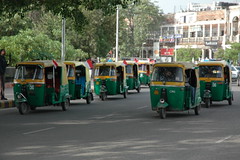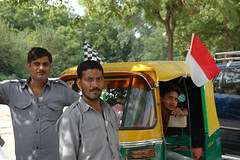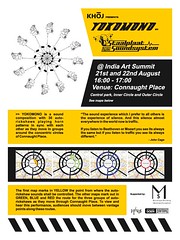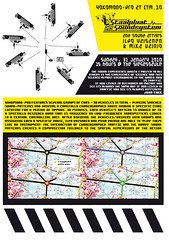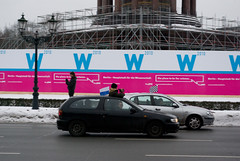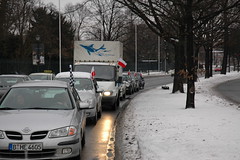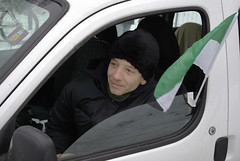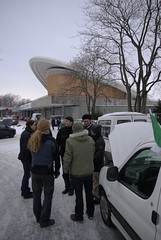YOKOMONO-PRO
Yokomono-pro is part of the Achitone project but becoming a separate project so that we gave it its own page.
Yokomono-Pro
Where do we draw the line between noise and sound? What sounds constitute noise and when do we speak of music (and what sounds do we simply call sound)? These questions are at play in Yokomono Pro.
The first version of this honking car concerto was made in New Delhi in 2009. Taxis there carve their way through traffic by honking. They manifest themselves through their horns and use them to position themselves within a certain structure. The result of all those horns busily structuring, sounds like unstructured chaos; they transform their surroundings into a teeming multitude of micro-sites. That chaos is Staalplaat’s subject, its object, its instrument. It is the raw matter they mold into a composition.
Sometimes music is organized chaos (Yokomono). Sometimes chaos is organized into music (Yokomono Pro). The level of organization co-determines the difference between noise, sound, and music. But there is another factor, one that is part of the environment and determines the transition, determines the experience of the dividing line proper. That factor is the listener, who in many cases is also a spectator. The moment there is a listener, structuring happens. And in this way every noise is ultimately transformed into sound.
Idea
Yokomono-Pro is a car horn concert performed by vehicles moving through a city. Each city and each type of vehicle has its own tone and each combination results in a different concert. The project was developed and written as a commission by the International Sonic Residency 2008 for The KHOJ Artists’ Association in New Delhi and was presented one year later at the India Art Summit. In New Delhi we focused on the traffic and the amazing amount of noise it produces. One of the most prominent noisemakers is the three-wheel taxi, which uses its horn very frequently in situations where we would use our indicators, headlights or mirrors. Taxis are the most recognisable means of transport here, playing a dominant role in the city’s soundscape. We arranged for the collaboration of thirty so-called ‘tuck tuck’ taxis and operated their horns via remote by means of transmitters. By playing this ‘taxi horn choir’ in combination with spatial manoeuvres an urban sound choreography was created. Yokomono-pro has also been performed at the Transmediale in Berlin, at TodaysArt in The Hague and at Timelab in Gent.
Yokomono-Pro can be thought of as a ‘car orchestra’ with the car horn as its instrument, or as a ‘John Cage happening’, as a choreography or refined celebration of a football victory or a marriage. And it is all that, but then again it’s not that simple. It involves movement and sound in the public space and that makes it different, in many ways, from a traditional performance with static instruments in a closed environment. Also, the car is a ‘charged’ object, occupying an important economic and social position, while evoking varying associations and emotions. As an urban composer the challenge for me is to redefine this dominant element in our surroundings and find structure and harmony for it.
Technique
While developing the project we found that it was crucial to control the horns from one central point instead of having the taxi drivers play from a score. They were incapable of using the horn at the exact moments that were prescribed by the score, which made it impossible to arrive at some sort of synchronicity.
Therefore the idea presented itself to use a remote control in the form of a transmitting system for the horns. The system had to be both simple and usable anywhere in the world. This was easier said than done: we had to build a system with specially designed hardware. Nevertheless, we decided to build everything again from scratch in New Delhi, Berlin and The Hague, as the system did not perform as expected.
We are now using six telephone channels distributed among the cars via W-lan.
The orchestra is complete now, the compositions have been performed internationally three times and the technique is now stable. I wrote the first compositions without really knowing the character of this instrument. These pieces had as their main ingredients atonal timbres and movement, exploring the musical possibilities of the orchestra and its possible social role. With the information thus gathered I can now go one step further and focus on composing works that specifically address the social function of the automobile as a medium, taking into account the experiences and insights I have gained so far.
Project 1: Yokomono-pro XXL
In this project we explore the tonal character of the horn and its possibilities. Car horns are designed to produce short range signals. A little further away they soon become inaudible, which makes it hard to work in a truly spatial way. That’s why, we want to take the city itself as a sound subject. To achieve this we have chosen a setup that involves thirty circulating trucks, controlled by us. By playing the horns of these trucks as they circulate, we emphasise the urban dimensions. Movement and sound together create a sonic choreography within the soundscape of the city. There will be two routes for the trucks: one circling an intersection and one shaped like a flower around it . Four of the trucks will be parked at designated points. The composition consists of eight channels: two for the circle, two for the flower, and four for the stationary trucks.
Project 2: Plan Marriage
This concerns the social nature of the car in our society. The Turkish community traditionally they celebrate marriages by forming a procession of cars that sound their horns. In Western cultures as well music forms an integral part of marriage ceremonies.
In collaboration with the Turkish community – we want to expand and harmonise this Turkish horn sounding tradition with our technology. Our compositions will incorporate traditional Turkish rhythm patterns as well as modern techno, as both are part of this second generation of young Turks’ culture.
We want to write several compositions together with Turkish musicians and together with car companies and young people build the technique, which will then stay in Ghent. Instead of realising a unique, one-time project here, we want to leave behind a permanent change in an existing tradition. I regard this as one of the most important and most challenging ambitions of my work.
Project 3: Plan Requiem
The funeral procession is a special tradition, also now that cars are used, and used to be accompanied by music before it was transformed into a mostly sterile and formal occasion.
I intend to extend the present tradition of the funeral procession with a car requiem. I realise that this is a sensitive and very personal issue, and therefore I have decided to literally keep it personal: together with my brother, the visual artist Erik Hobijn with whom I also did Station to Station, I will write a requiem for my father, who is still alive.
The requiem will consist of two parts. The journey to the cemetery consists of slowly building layers of long notes and a line of cars snaking through the city. The journey back is in strong contrast with this and is short and happy. Celebrations are in order.



